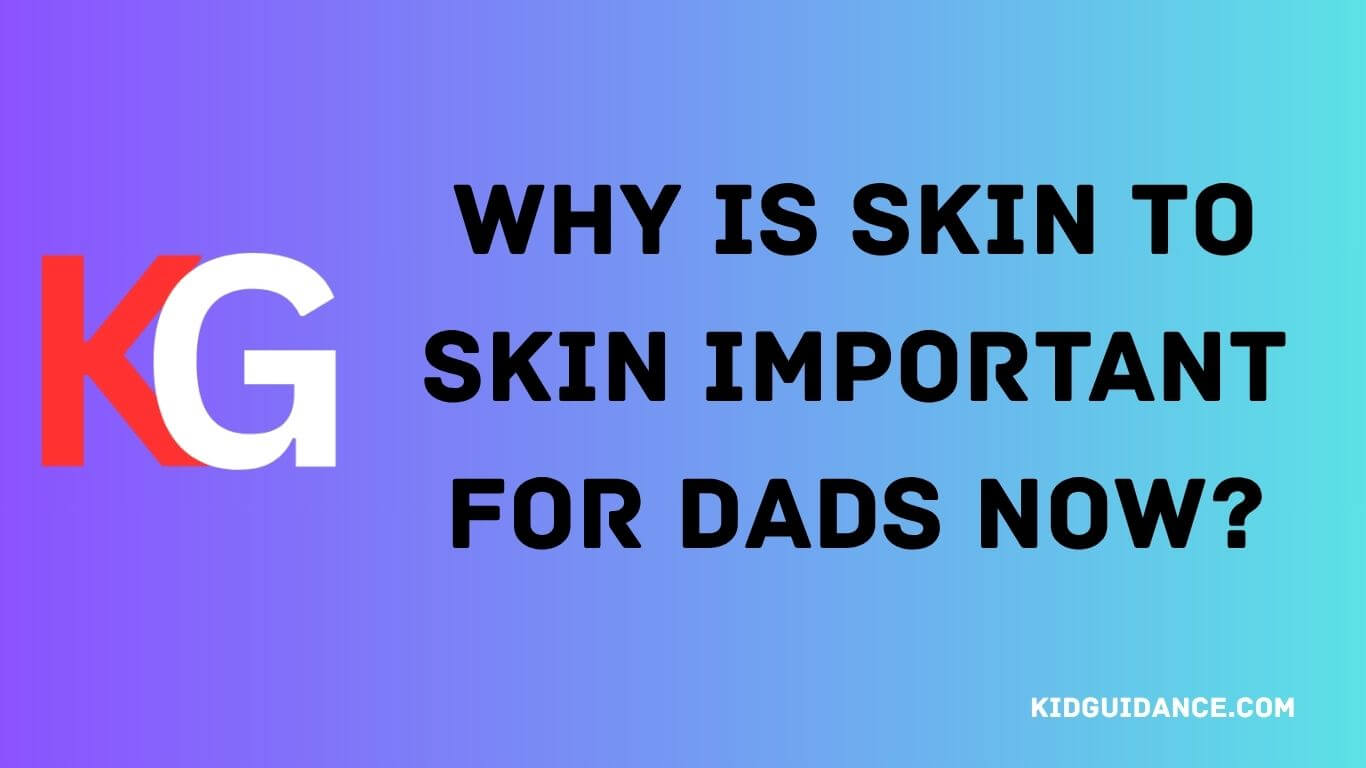Why is skin-to-skin important for dads? It’s more than just a sweet moment. It’s a powerful way to bond. The first time I held my baby, skin to skin, I felt something shift. I wasn’t just watching—I was in it. I was a dad. In this guide, I’ll share what I’ve learned, what the research says, and why every new father should try this special connection.
This practice is called skin-to-skin contact—or kangaroo care. You place your baby on your bare chest, and something beautiful happens. Your baby feels calm. You feel calm. And together, you begin a bond that can last a lifetime. Let’s explore how skin-to-skin helps dads, helps babies, and becomes one of your first real parenting wins.
What Is Skin-to-Skin Contact and Why Does It Matter?
Skin-to-skin means placing your baby—wearing just a diaper—directly onto your bare chest. You can cover them with a blanket for warmth. It can happen in the delivery room, at home, or even during a NICU stay.
This idea started in hospitals for preemies, but it’s now a proven best practice for all babies. Research shows it helps stabilize the baby’s breathing, body temperature, and even blood sugar. But here’s the twist—it’s not just for moms. Dads can do it, too.
Is Skin-to-Skin Better with Mum or Dad?
Let’s be clear—both are great, and it’s not a competition. Moms usually get first dibs, especially if they’re breastfeeding. But dads bring their own magic. Studies show that fathers release oxytocin (aka the love hormone) during skin-to-skin, just like moms do. One dad I know said he wasn’t sure what to expect—but when his daughter opened her eyes and locked onto him, he said, “It’s like the rest of the room disappeared.”
Why Is Skin-to-Skin Important for Dads?
So, let’s answer the question directly: Why is skin-to-skin important for dads?
1. It Builds a Deep Emotional Bond
Skin-to-skin triggers oxytocin and dopamine—chemicals that help dads fall in love with their baby and feel connected. This isn’t just about cuddles. It’s brain chemistry.
2. It Increases Confidence in Fatherhood
Many dads feel unsure at first. Holding your baby skin-to-skin makes you feel like, “I’ve got this.” And the baby feels it, too.
3. It Lowers Stress for Both of You
Newborns cry less during skin-to-skin, and dads often report feeling calmer, more focused, and less anxious.
4. It Shapes Long-Term Attachment
That early connection sets the stage for secure attachment. Studies show that involved dads raise more emotionally secure kids. Skin-to-skin is one of the first steps toward that.
Research shows that oxytocin levels in dads increase significantly after just 15 minutes of skin-to-skin contact. This hormonal surge is linked to stronger feelings of protectiveness and bonding.
The Golden Hour: What It Means for Dads
You’ve probably heard of “the golden hour”—the first hour after birth. It’s not just a sweet moment. It’s a critical window when a newborn’s brain is most sensitive to bonding cues: smell, voice, heartbeat, warmth.
What Is the Golden Hour After Birth for Dads?
If mom is recovering—say, after a C-section or stitches—that’s dad’s moment to shine. Hospitals are more and more supportive of this, especially if it’s in the birth plan. One dad told me he held his baby for an hour while his wife was being stitched up. “It was just me and her. And it felt right.”
How Long Should Fathers Do Skin-to-Skin?
There’s no one-size-fits-all. But here’s a helpful guide:
- At birth: Aim for 30 minutes to 1 hour if possible.
- First week: Daily skin-to-skin sessions, 15–30 minutes, especially during feedings or naps.
- First few months: Continue as long as the baby enjoys it. Many dads do skin-to-skin while bottle-feeding or rocking their baby to sleep.
NICU dads or working dads? Even short sessions help. One NICU nurse I spoke with said, “Ten minutes can lower a baby’s stress markers. That’s powerful.”
Can a Baby Sense Who Their Father Is?
Yes—and it’s amazing.
Babies know their father’s voice, smell, and even heartbeat rhythm. Your baby has been hearing your voice in the womb. Skin-to-skin strengthens that familiarity.
Over time, your baby begins to associate your scent, warmth, and voice with safety and comfort. One dad told me, “My son calmed down faster with me than with anyone else. I didn’t think that was possible, but he knew me.”
Addressing Common Myths and Concerns
- “Only moms need to do skin-to-skin.” Nope. Dads matter too—and your involvement has unique emotional and biological effects.
- “It feels awkward.” Sure, at first. Especially if you’re in a hospital gown and people are walking in and out. But give it 5 minutes. The baby calms. You calm. You’ll forget the rest of the room.
- “Hospitals don’t allow it.” Most do—but check in advance and add it to your birth plan.
A dad once told me, “I thought it was a ‘mom thing.’ But once I did it, I felt like a dad in the deepest sense. She looked at me like she already knew me.”
Real-Life Experiences: What Dads Say
- “She stopped crying as soon as I held her to my chest.”
- “He looked right at me like, ‘Oh, it’s you.’ I’ll never forget it.”
- “It made me feel like I mattered—that I wasn’t just the helper, I was the parent.”
Have a story? Share your skin-to-skin moment with us. We want to hear it.
Final Thoughts: Dads, Don’t Miss This Moment
Skin-to-skin isn’t just for moms. It’s not just cute or nice. It’s science-backed. It helps your baby regulate temperature, heart rate, and stress. It helps you feel bonded, calm, and ready to be the amazing dad your child already believes you are.
So whether it’s in the delivery room, at home, or during those 3 a.m. wake-ups—make time for skin-to-skin. You won’t regret it.
Why is skin-to-skin important for dads? Because those quiet, bare-chested moments can shape a lifetime of love, trust, and connection.
FAQ:
Q1. Why is skin-to-skin important for dads?
Skin-to-skin helps dads bond with their baby, lowers stress, and boosts confidence. It also supports baby’s heart rate, warmth, and emotional growth.
Q2. What is the golden hour after birth for dads?
The golden hour is the first hour after birth. It’s when skin-to-skin can help dads and babies form a strong, lasting emotional connection.
Q3. How long should fathers do skin-to-skin contact?
Fathers can start with 30–60 minutes after birth. Short daily sessions in the first few weeks also help build bonding and calm the baby.
Q4. Can a baby sense who their father is during skin-to-skin?
Yes, babies know their dad’s smell, voice, and touch. Skin-to-skin helps them feel safe and builds trust from the very start.
Q5. Is skin-to-skin better with mom or dad?
Both parents give benefits. Moms help with feeding and warmth. Dads help babies feel calm, safe, and loved too. Both are important.
Q6. Can dads do skin-to-skin later if they missed the golden hour?
Yes, dads can start skin-to-skin anytime in the first weeks or months. It still helps babies feel secure and supports bonding.
Q7. Does skin-to-skin help dads feel more confident?
Yes. Holding a baby close can make dads feel needed and connected. It builds confidence in newborn care and emotional support.
Q8. Is skin-to-skin safe for dads to do at home?
Yes. Just sit or lie down, hold your baby on your chest, and stay alert. Avoid using your phone and make sure baby can breathe easily.
Q9. Can skin-to-skin contact reduce a baby’s crying?
Yes. Babies held skin-to-skin cry less. They feel warm, safe, and calm, which helps lower stress and improve sleep.
Q10. Is skin-to-skin good during bottle feeding?
Absolutely. Shirtless bottle feeding offers the same closeness and bonding. Dads can use this time to grow trust and connection.




